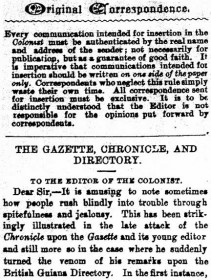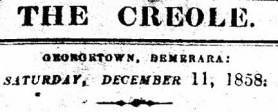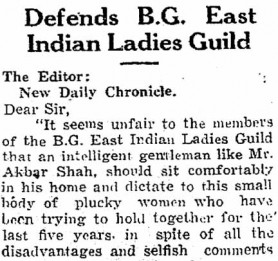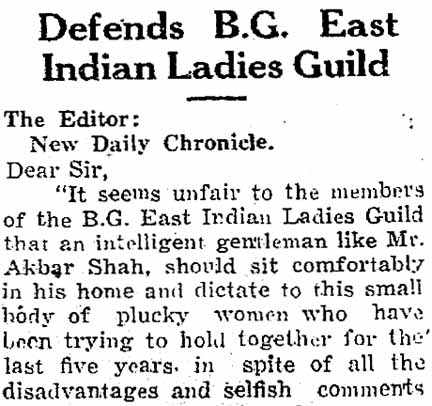By Nigel Westmaas
On January 4, 2010, a regular letter writer to the Guyana press, Leon J Suseran, was quoted in Stabroek News as complaining that he might have been victimized for views he expressed in letters to the newspaper. “I want to make it public that I am being threatened because of my public comments,” Suseran told the Stabroek News – even as he vowed not to be silenced by anyone and to continue to expose the ills as he saw them.
What the Suseran incident indicates is that in Guyana with its “electoral democracy” criticizing the government in the media, in this case the newspapers, can lead to punitive reaction from the state and its officials. Other regular letter writers who mainly target the non-state press have complained of their letters being shortened/edited or the failure of the newspapers to print their letters.

Today, in the absence of street demonstrations and major pickets, and because of state restrictions on forums such as independent radio stations, the letters to the editor column has become a key arena for airing citizen complaints about poor governance and social and political dysfunction. It is, in effect, a necessary form of protest. Given its expanded role in shaping public debate, what impact and influence does a letter to the editor have in Guyana? In some newspapers responses online provide valuable feedback to both the editors and readers – as is the case with the Stabroek News letter column and news items. If there is a downside of the immediate response online it is in the anonymity of the bloggers with pseudonyms and nasty invective to boot; in fact the anonymity permits the invective. The upside is that comments on a news item or letter can be easily and instantly posted. From the available evidence, responses to the letter columns appear to generate the largest number of comments from the bloggers. In any event, the “letters to the editor” section is an important institution of the public sphere in Guyana.
Letter writers do not receive material compensation for their efforts, but do enjoy rewards such as publicity or satisfaction from directly or indirectly influencing public discourse. The newspaper letter scribe employs all types of rhetorical strategies mediated by tone, scope, and coherence (or incoherence). In the era of substantial changes in mass communication questions arise. Who reads and how thoroughly do they read the average newspaper? Do rural and interior Guyanese have the same daily access to newspapers? It is understandably difficult to measure ‘impact’ or the scale of readership. Perhaps the newspapers themselves have a distinct edge in assessing their own circulation figures and locations. Whatever the circulation and reach of the Guyana letter column(s) there is understandably more focus on local concerns at the expense of international developments. This stems from the overwhelmingly dark crisis that overwhelms even the strongest citizen, rendering “survival” at home the key preoccupation.
Letters in local history
In Guyana the newspaper and its letter column have had a long history of subtle and open restriction on published material. While the press generally appeared to operate in a liberal climate, it was also true that editors were harassed from time to time for what they allowed to be published. The birth of the Guyanese press in 1793-94 began a pattern that would result in the prominence of a few newspapers for over a century. This included the Royal Gazette. Launched in 1803 and a survivor for the greater part of the nineteenth century the Royal Gazette adopted “the line that a newspaper should serve the “public interest” while other papers, notably the Colonist, were unabashedly pro-planter and made this clear at every opportunity and would restrict or entertain letters in accordance with editorial philosophy.
Publishing in the era of post-emancipation ferment provided for an anxious colonial state. The 1839 newspaper law (significantly introduced just one year shy of slave emancipation) was a very draconian piece of legislation. This law sought for example to prevent the “publication of libellous articles” and by extension letters carried a cautionary bond of $500 exacted from the intended publisher.
In the nineteenth century the plantation economy, race, conditions and circumstances of the working people and the unemployed as well as concerns of the planter class inundated the press in discussion and debate. The very large broadsheets of the early newspapers allowed for comparatively long letters. Many were excessively enthusiastic in their Victorian expressions. Phrases like “exuberant frolicsomeness,” “frowsiest of the fraternity” and “phantasmal penumbra” were standard for that time. It was the convention of letter writers to employ sobriquets for their letters and certain popular titles emerged: Pendragon, Africanus, Sambo, Civis, Anti-Humbug, Fairplay, Veritas Azopia, Lady Blake, Negro, Scrutator, Lambada, Thomas Tit, Avaro, Fr Gilzean ( during the Cent Bread riots of 1889), Pax, Vox Populi (Voice of the people), Enquirer, Canje Planter, and Verax. There was even a letter written by a “Ruined Planter” who, obviously distraught at abolition, wrote to the Royal Gazette in the eventful year of the Abolition Act, 1834. Censorship alternating with liberal moments was typical of the press in general all the way up to the present.
Black newspapers and their letters
The debate in the press on the problems associated with being an African or a ‘Negro’ moved to another level when the Black press joined the fray with the emergence of the Freeman Sentinel in 1842. Of the approximately 45 newspapers published in British Guiana in the 19th century, at least nine were owned and edited by African-Guianese. This was no small achievement given the severe economic and political restrictions the Africans faced after years of enslavement, and attendant physical and psychological deprivations. These newspapers ranged from the Freeman Sentinel to the Reflector and Echo later in this century. Invariably, the activity of the African-Guyanese press threatened the establishment.

“The spirit which has actuated and brought into play negro slavery, has outlived its time and generation; but it is old, bed ridden and impotent. It has grown, thereby, irritable and malignant, and not infrequently, in its restless slumbers, convulsed by periodic nightmares at the phantasmal penumbra of some ill-treated, now long departed, pointing at it a dart of vengeance, awakening in this state of passive delusion a gaunt ogre finds itself weltering in spectrum of pessimistic fancies which can only be analysed by venting up spleen at the expense of the children of a people it had wronged.”
Other letter writers expressed racial concerns with the Daily Chronicle on its reporting over the Cent Bread riot three years earlier in 1889. Letters sent by “Sambo” and “Azopia” on different days blasted the paper. For his part “Sambo” disputed the Daily Chronicle’s allegedly biased reporting on the riot. “If the editor,” Sambo mused, “had been watching the signs of the times, and had given utterance to his inmost conviction, he would have seen, no matter how much his mental vision is darkened by negro prejudice… that Black people were on the watch, and had fully made up their minds that a like misuse of power would not be tolerated.”
Bechu, the Indian Scribe and his successors
Towards the last decade of the 19th century Bechu, the best known Indian scribe was in his element. Between 1896-1901, as recorded by historian Clem Seecharan, Bechu hurled his well-argued missives against colonial conditions through the letter column. Bechu’s main line of attack was on the conditions of work of Indian immigrants and workers and the behaviour of the British Guiana planter class, his main target, towards them. There was an obvious impact as the planters and representatives of the colony’s government took time to respond to his detailed rejoinders. One of Bechu’s planter critics called himself “West Coast.” Evidently this member of the planter class found it necessary to hide his identity. “West Coast” according to Seecharan’s text complained that Bechu’s letters “were becoming too frequent and… monotonous.” In response Bechu accused “West Coast” of cowardice and “lacking ‘a spark of manliness,’ for not using his real name.” Seecharan argues that the “rebellious” letter-writing spirit of Bechu was contagious as other Indian Guyanese began to challenge the authorities more and more in the press. Joseph Ruhoman was one influenced by Bechu. His missives coincided with Bechu’s and continued into the early twentieth century.
Letter activity in the 20th century
Many of the same concerns over sugar, labour, constitutional reform and working class concerns and struggles in twentieth century colonial Guyana were just as intensely discussed in the press as in the previous century. All through the 20th century well-known letter writers were embroiled in debate and controversy on all sorts of matters. But there were rules on who could be public. Laws existed in colonial Guiana and the other colonies that precluded civil servants from addressing the press on affairs of the government. Public servants could not therefore write under their own names.

Role and impact of the contemporary letter
There is no fixed pattern to letters and regularity of output is difficult to establish while topics vary with the age. In recent times another set of regular responders have taken up the cudgels of discussion and debate. Subjects include potholes, garbage in the city, condition of the cemeteries, treatment from government departments, blackouts, minibus driver behaviour, the state of public utilities, the courts, attitude of government officials, race relations, corruption, crime, drugs, violence – domestic, sexual, racial and state violence – the use of corporal punishment, gay rights, women’s rights, indigenous rights, and the never ending political debate. There are phases to responses. When topical issues like the Roger Khan scandal emerge, for example, there is an initial spurt of letter-writing; periods of silence, and then a vigorous return if issues (and energy) return. Some incident, political happening or statement can impel an episode of writing and response until the letter combatants are themselves tired or the editor steps in with the classic protective moral, “This correspondence is now closed.” Energy or synergy is important because Guyana, besieged as it is with so many problems and the seemingly endless inability of successive governments (and the society within) to effect fundamental change to the political and social system and restore confidence, can daunt even the strongest-willed Guyanese from bothering to express his or her views in the press.
Inevitably, a new band of consistent letter-writers have joined their forebears. Among these are ‘consistent’ names like Emile Mervin, WP George, GHK Lall, Freddie Kissoon (apart from his daily column) Tacuma Ogunseye, Eric Phillips, David deGroot, Oliver Sam, Andaiye, Norman Browne, Clement Rohee, Janet Bulkan, M Xiu Quan Balgobind-Hackett, Annan Boodram, Karen de Souza, Joey Jagan, Abu Bakr, Leon Suseran, Hemraj Muniram, Prem Misir, David Hinds, F Skinner, Mahadeo Panchu, Vishnu Bisram, Hamilton Green, Frank Fyffe, Devanand Bhagwan, Clinton Urling, Vidya Kissoon, Shane Rizwan, Michael Maxwell, Robin Williams, Lurlene Nestor, Dennis Wiggins, Sasenarine Singh, Barrington Braithwaite, Lincoln Lewis, Roger Williams, Chris Ram, and organizations like Red Thread whose letters are often co-signed by different members.
The letter writers in the Stabroek News and Kaieteur News are counterposed to the state owned Guyana Chronicle which only allows pro-government letters and a plethora of fictional ‘responders’ to letters and news in the popular newspapers. The situation is so bad that genuine letter-writers in the country rarely bother to send their letters to the Chronicle or the pro-government Guyana Times. A veteran New York Times letters editor once said, “We’re not amused by impostors.” So they check to apprise themselves of the authenticity of the writer. In Guyana the only state paper (as under the previous regime) is so thoroughly controlled by the government that a set of convenient names are employed to defend the regime against opposition critics or columnists like Freddie Kissoon. The difference between the pseudonyms utilized by letter writers in the nineteenth century and those written in the Chronicle in the present day is straightforward. The 19th century use of pseudonyms was defined by fear of the colonial state and by extension libel laws. In the modern usage of the state newspaper the basis for propaganda is so weak that the state itself has to employ fictional names for the letter column.
Future of letters
The letter is ephemeral. It provides a momentary ‘sting’ which defines the topic for a moment as urgent or very topical, and the longevity of a letter debate is determined by the vigour of response and debate. So influential is the letter column as a fall-back venue for ‘venting’ that Guyanese who fail to pen their feelings in this medium can be deemed ostriches or worse.
News today, unlike its nineteenth century counterpart is ‘instant.’ Telephone calls, text messages, twitter and Skype lessen the distance if only in informational terms. For those ‘outside’ the geographical space of Guyana, newspapers can be read online before they can be picked up at newsstands at home. Guyanese abroad do contribute significantly to the letter column on local concerns, although distance from context can lead to accusations of being ‘perched pontificators,’ to borrow an old expression. And what is the future of letters? Will this old and famous form of expression disappear, victim of newer forms of communication, that is, blogs and sometimes mindless twitter?
It appears that letters to the editor will hold its own for some time to come. And the new forms of texting and twitter can complement rather than displace that mode. One thing is certain, once the list of Guyana’s woes and despair grows the angst and response in letters will continue.
Let the “last word” go to the classic finale of a letter sent to the Colonist on August 13, 1883:
Thanking you for the space
I remain, Dear Sir
Yours truly,
Vox Populi






